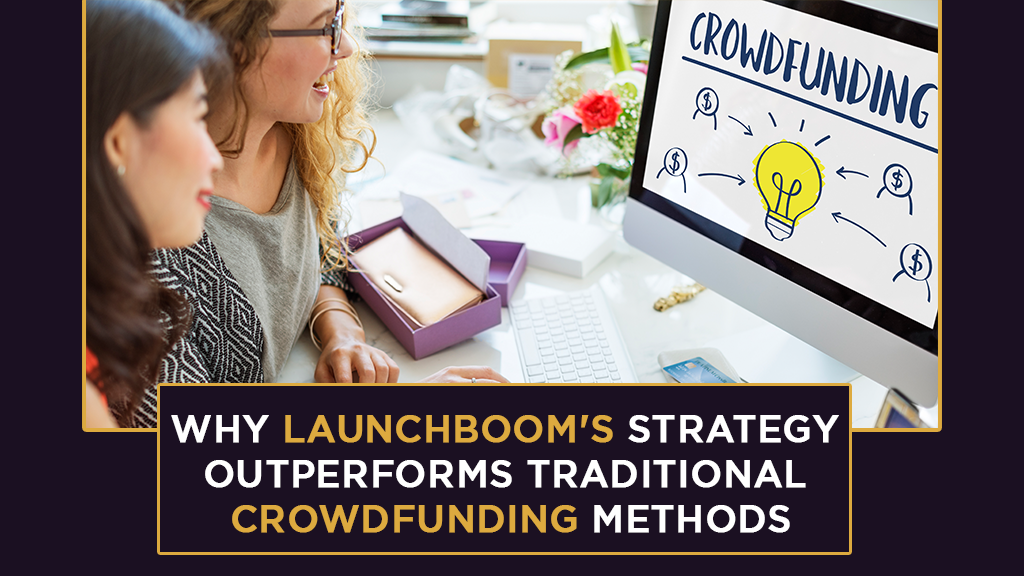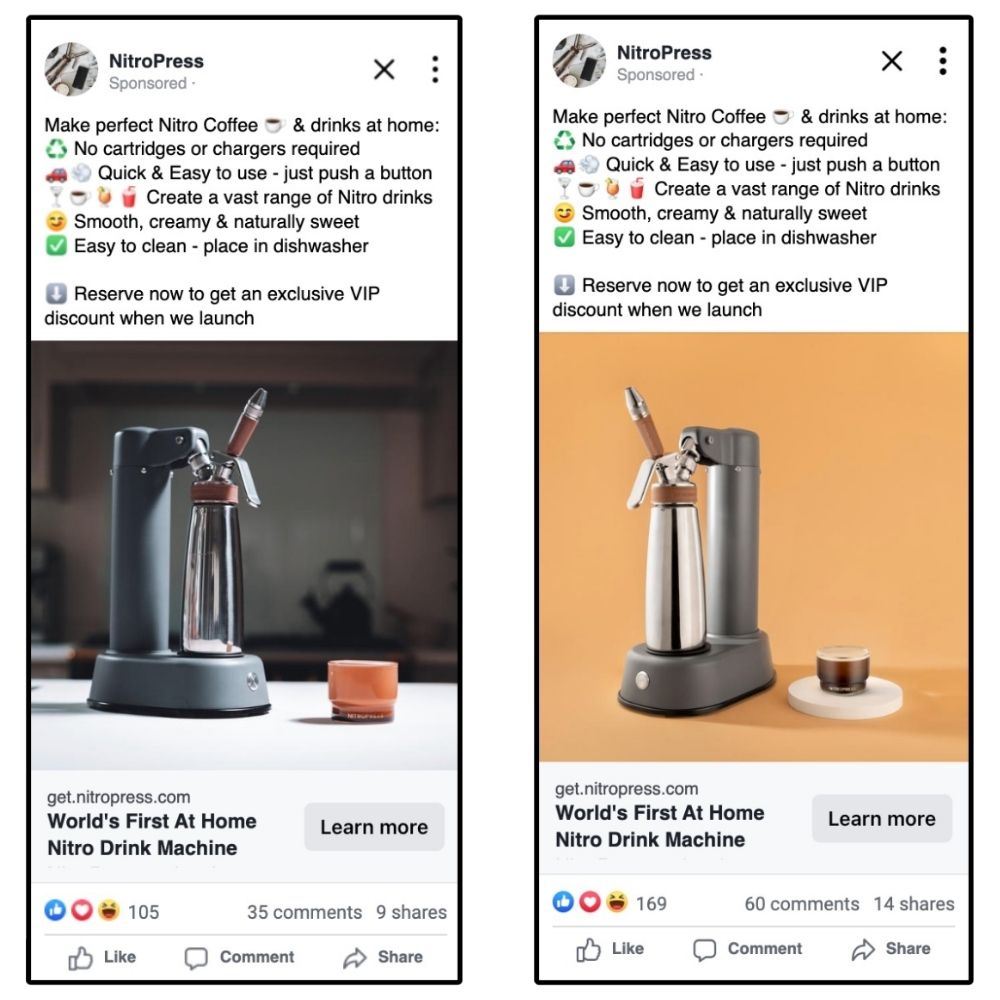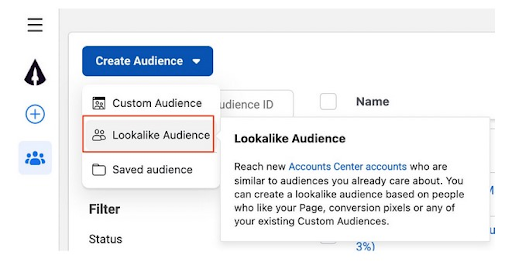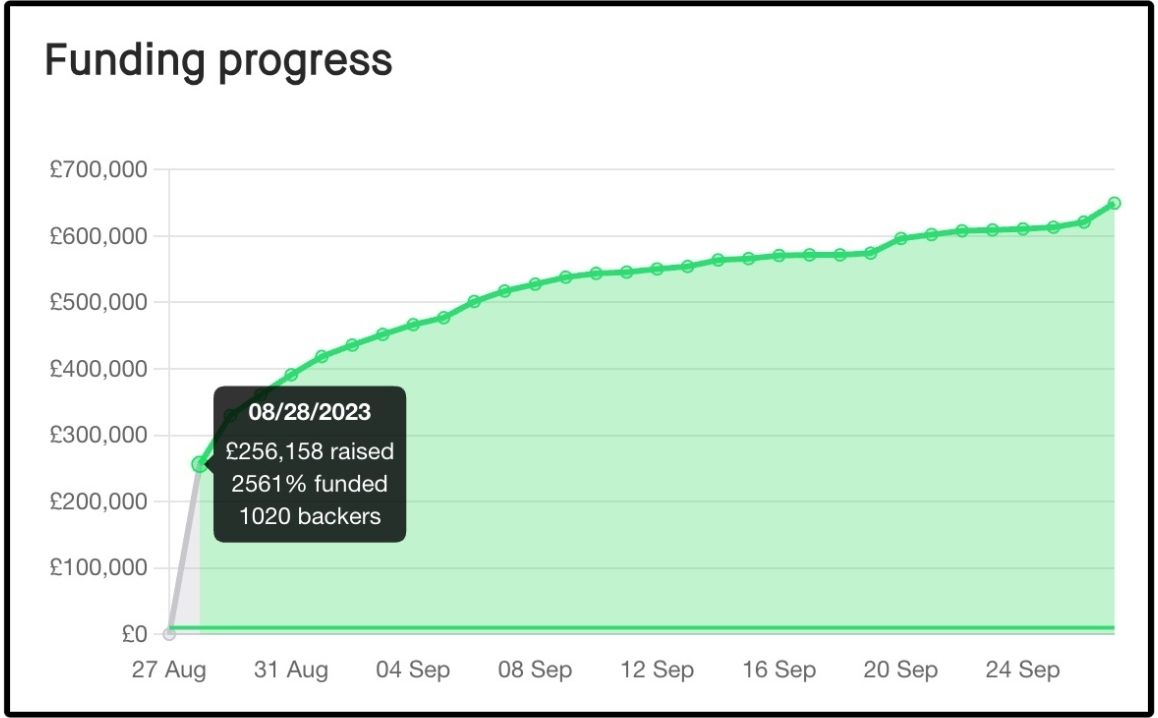
You’re thinking about, or getting ready to launch a new product on a crowdfunding platform like Kickstarter or Indiegogo. That’s great! But whether it’s your first time or your tenth time, one thing is for sure: you haven’t launched as many campaigns as LaunchBoom.
That may sound like boasting, but it’s more to make the point that we’ve taken many swings of the bat. Through countless failures and successes, we’ve honed a strategy that is proven to outperform other traditional crowdfunding methods you may have read about.
Don’t believe me? What if I told you there’s a way to know if your crowdfunding campaign is going to succeed before launch?
If there’s one thing we’ve learned after all these years of crowdfunding, it’s this: prelaunch is everything. At LaunchBoom, we live by the mantra “test, launch, scale,” and our aim is to help creators like you harness this data-driven approach to minimize guesswork and maximize ROI.
It’s not easy, and it takes doing a lot of little things well, but if you nail the LaunchBoom strategy, you’ll very likely be on the path to a successful crowdfunding campaign. Let’s explore how and why the strategy works.
Contents
Understanding the crowdfunding landscape
The first thing you need to do before deciding to crowdfund is to know what you’re up against. Here are some of the numbers you need to be aware of:
- The Good: At the end of 2022, Kickstarter and Indiegogo passed a combined $10 billion raised on their platforms, indicating thriving communities of potential backers for your product.
- The Bad: The average success rate of crowdfunding campaigns worldwide is only about 22%.
- The Ugly: Less than 2% ever reach $100 thousand and only 0.1% ever hit the elusive $1 million).
Some of those statistics may sound discouraging, but it doesn’t take away from the fact that crowdfunding can be a powerful tool when done right.
There are always risks involved, whether you’re starting your own business or running a crowdfunding campaign. But mitigation is key, and that’s what the LaunchBoom strategy is all about. That brings us to the first — and arguably most important — phase of the strategy: prelaunch.
Proven effectiveness of LaunchBoom
By now you’re probably asking yourself what it is about the prelaunch, or “test phase,” that makes it so crucial to crowdfunding success. It’s no exaggeration to say that this process is the bread and butter of the LaunchBoom strategy because of how much it teaches you about your product, your target audience, and how best to advertise.
All of the time, money, and effort that you put in during prelaunch will save you magnitudes more down the line, and it all starts with product validation. I know you have a great product, and you know you have a great product, but the world doesn’t know that yet.
Don’t worry, though, they will — and you’re going to show them as you methodically build your campaign’s reservation funnel.
Reservation funnel setup
Prelaunch is where you get to hone your marketing strategy. But in order to do this, you need to have something to start with.
This includes creating your minimum viable product (MVP), or a version of your product that allows you to collect the maximum amount of validated learning about customers with the least amount of effort. If you have a working physical prototype that you can use, that’s great; if you don’t, we’ve found that photorealistic renderings perform just as well.
The other thing you’ll need is an initial strategy for your messaging and positioning. This can include two to three of your strongest messaging angles that you believe best convey the value of your product. These, along with the imagery, are what you’ll use to start fueling traffic into your reservation funnel.
Here’s a basic overview of what the funnel looks like:

Ultimately, your goal is to get people to reserve a spot for launch day by putting down a $1 reservation deposit. This $1 deposit represents much higher purchase intent than someone who only gives you their email. In fact, those that put down a $1 deposit are 30 times more likely to buy. Because the $1 deposit is such a strong indicator of purchase intent, you can actually predict how much you will likely raise on launch day based on how many reservation deposits you collect.
Product testing and validation
With the reservation funnel set up, you’re now ready to start sending traffic. The best way to do this is with Meta (Facebook/Instagram) ads. Driving traffic to your reservation funnel is going to allow you to collect a lot of valuable data. This data can then be used to test product positioning and ultimately, validate demand for your product.
The most important metric you’ll be looking at is your cost per reservation (CPR). Ideally, you want this to be below 20% of the price point of your product. So, if your product is $100, you want your CPR to be less than $20.
Let’s look at an example of two high-converting ads from a recent campaign that used the LaunchBoom strategy.

Some important things to note about these ads are the copy and the images. Let’s first talk about the ad imagery, which is key in catching the eyes of scrollers. Images are so important that it’s what we always test first. Many different images were tested for NitroPress, but these came out on top.
Now let’s look at the ad copy. Both make use of the same copy, because after thorough testing this combination of headlines and text performed best.
At the end of the day, data is king. Follow its lead to learn what the market is responding to, and if necessary you can pivot your positioning (or even your entire product) early in the process.
Audience building
Once you’ve validated your product in the market, it’s time to start scaling your audience building. First, you’ll want to increase your budget on the winning ads and see how your metrics are affected. If your CPR holds strong after a few days of increased spend, bump it up again. Keep doing this until you start to see some decay in your ad metrics.
Another strategy we like to use is creating lookalike audiences. A lookalike audience is a feature in Meta where you upload a seed audience (like an email list) and Meta builds you a new audience with similar demographics and interests as your seed audience.
Once your prelaunch email list gets to a few thousand subscribers, upload it into Meta and create your lookalike audience.

You can also refine your audiences by using “narrowing” and “exclusion” techniques. Here’s a closer look at how best to use those:
Exclusions
- Custom audiences: Exclude all of your lookalike audiences, other lists, and web traffic custom audiences.
- Locations: Exclude locations where you don’t want your ad to appear.
Narrowing
- Demographics: Choose an age range and gender that you believe matches your target customer.
- Language: Select English All under language, unless you plan to run ads in a different language.
- Technology: If your product requires a certain technology to operate, make sure you narrow by that technology.
- Interest: Narrow by Kickstarter, Indiegogo, and Crowdfunding, because people who know about these are more likely to purchase.
Launch
With your strong prelaunch foundation built, you’re ready to launch. This is the time when the LaunchBoom strategy really demonstrates how it outperforms traditional methods.
How? Because if you’ve done everything right, you should be able to reach your funding goal in the first twenty-four hours of being live. In fact, on average, campaigns that use this strategy get funded in the first 15 minutes.
Using the prelaunch email list you’ve built, you’ll be able to drive a huge amount of traffic and revenue to your campaign page. This all-important injection of funding into the campaign can then be leveraged into driving momentum and more interest in your product for the remainder of the campaign.
Remember NitroPress from earlier? Here’s how much they were able to raise after the first day:

This didn’t happen by accident. Thanks to the predictability of our system, we knew it would by looking at some key metrics gathered from prelaunch.
- Ad spend: £21,869.63
- Total leads: 12,000
- Total $1 reservations: 1,122
- Cost per lead (CPL): £1.82
- Cost per reservation (CPR): £19.49
The prelaunch list alone drove £94,575 in revenue, representing a 4.32x direct return on ad spend. As for the remaining £161,583, most of those backers came organically through the Kickstarter algorithm when the site ranked the NitroPress campaign highly on the site thanks to its massive early funding.
With this, you can really see the power of the $1 reservation and how likely it is to get people to back your crowdfunding campaign.
Real-world success stories of ROI with LaunchBoom
At this point you might be thinking: Everyone drinks coffee, of course NitroPress was able to generate that many prelaunch reservations and secure their funding. But the amazing thing about the LaunchBoom strategy is that its principles apply no matter what the price point or product category.
Let’s analyze two other crowdfunding case studies that are very different from household coffee appliances.
Nomad’s Pad

Nomad’s Pad was a campaign by two entrepreneurs whose ambition was to create a new kind of glamping experience in the Arizona desert. At a $500 starting price point for backers, this might sound like it was a tough sell; however, we were able to generate positive prelaunch metrics that indicated they would have a successful launch day by tweaking one aspect of the $1 reservation funnel to suit their steeper price.
Instead of securing a reservation with only $1, we decided to increase the VIP reservation cost to $50. Looking at the same metrics as NitroPress, here’s what happened:
- Ad spend: $44,515.80
- Total leads: 22,844
- Total $50 reservations: 916
- Cost per lead (CPL): $1.94
- Cost per reservation (CPR): $48.60
By using product validation best practices as detailed in this article, we were able to build the right audience for this campaign. Before launch day, we generated a total of 916 reservations which drove $358,602 in funding in the first 24 hours.
And as an added bonus, Nomad’s Pad was able to earn more money through reservations than they spent on advertising. 916 people made the $50 reservation to get VIP access to the campaign on launch day, totaling $45,800. Total ad spend was only $44,515.80, equaling $1,284.20 in profit. Not too shabby of a ROI thanks to a smart prelaunch.
Xion CyberX

With Xion CyberX, a fully customizable and futuristic looking eBike, we catered the $1 reservation strategy once more to fit the needs of the campaign.
This product was starting at $2,900 for people who wanted to back it. That’s a very high price to ask your average person to invest in crowdfunding. As with any other product, the principles of audience building remained the same despite the daunting price point: Generate a list of leads who are highly likely to convert. To scale with the starting price tag, we created a VIP tier list with different levels costing $100, $50, and $1 for varying prelaunch reservation perks.
The goal was to have the majority commit to the $100 reservation, which is actually only .03% of the price for the eBike. By offering enticing benefits for the highest tier of backer, we were able to get 954 out of a total 1,283 to deposit the full $100. Here’s a closer look:
- Ad spend: $103,665.71
- Total leads: 30,505
- Total $100 reservations: 954
- Total $50 reservations: 73
- Total $1 reservations: 256
- Cost per lead (CPL): $3.40
- Cost per reservation (CPR): $100
While this campaign was unable to break even in ad spend based on reservation revenue generated, the total out-of-pocket advertising costs ended up being just $18,677.88. That means we only ended up spending 18% of the original $103,665.71 in ad spend. That’s the potency of the LaunchBoom prelaunch strategy and reservation deposit in action.
Why choose LaunchBoom for your crowdfunding campaign
We’ve worked with over 1,000 product creators over the years, and the successes speak for themselves. More than anything, though, each campaign was built using the same foundational principles, which is why we’re so passionate about spreading the knowledge of the LaunchBoom strategy to those looking to transform their lives and businesses through crowdfunding — no matter the platform.
LaunchBoom & Kickstarter
LaunchBoom has a long track record with Kickstarter. In fact, it’s where we launched our first campaign as a marketing agency. And over the course of all the campaigns since then, you can bet we’ve learned a thing or two about how to cater your crowdfunding strategy towards a successful launch on Kickstarter.
One of the best recent developments by Kickstarter that will help maximize your implementation of the LaunchBoom strategy is the fact they have finally added the Meta Pixel. This tool, as it also does on Indiegogo, gives creators a way to measure the effectiveness of their Meta ads and incoming traffic to the campaign page.
Product category is also a major factor when building your strategy. Here are their three highest performing categories in terms of total funding dollars:
- Games: $2.12 billion
- Design: $1.54 billion
- Technology: $1.33 billion
Right away I can tell you that if you’re planning on launching a game, your product is going to be right at home on Kickstarter. Other notable categories that we’ve seen thrive better in the Kickstarter ecosystem vs. Indiegogo are graphic novels, art, music, and films.
Another important thing to be aware of when thinking about your crowdfunding strategy is that Kickstarter does not accept campaigns that do not have a functional prototype. It was mentioned earlier that renders can perform just as well as real photos, which does apply for running ads during prelaunch regardless of crowdfunding platform. Unfortunately, it just doesn’t apply to Kickstarter campaigns.
LaunchBoom & Indiegogo
Continuing on the point about functional prototypes, we know that not every creator is at that stage yet. To those who aren’t, we always recommend launching on Indiegogo thanks to them allowing products in the “concept” stage to have campaigns.
As far as what product categories we’ve seen perform well on Indiegogo, the list has a bit of overlap with Kickstarter’s list, albeit with a few standouts of its own. One category that has had success specifically on Indiegogo is lodging, glamping, and hotels. These campaigns are usually highly dependent on artistic renders, so if you’re thinking about starting your own unique getaway in a secluded dessert, plan to cater your crowdfunding strategy towards Indiegogo.
Also, if you’re thinking about launching something like an eBike, Indiegogo has grown into an unofficial home for these products, hosting several successful launches raising many millions of dollars over the years.
The LaunchBoom strategy: final thoughts
The road from start to finish in crowdfunding is a long one, and can sometimes feel like trying to navigate a forest without a map. Luckily, LaunchBoom can provide the GPS needed to confidently come out the other side.
Using the LaunchBoom crowdfunding strategy, you will be able to cheaply, easily, and predictably validate your product. If you do everything right and the numbers indicate success: great! If the numbers aren’t quite where you want them, that’s okay too.
There is nothing wrong with deciding not to launch your product, especially when you consider how much money you could be saving by not doing so.
We’ve seen so many cases over the years where creators used what they learned from their first reservation funnels to make data-driven changes to their product and marketing strategy which led to improvements that eventually translated to crowdfunding success. Remember that it’s a marathon, not a sprint.
“Test, launch, scale.” These are the words to live by when embarking on your crowdfunding journey. And if you’d like guidance preparing for the road ahead or want to learn more about our educational resources, reach out to us any time and we’d be happy to help.




